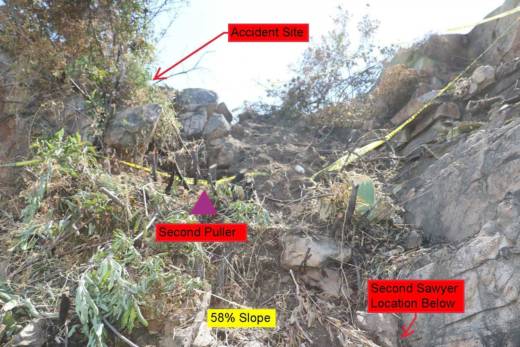Minutes after they began working, a sawyer on the other saw team lost his footing and slid down a hill.
Around 2:20 that afternoon -- in 92-degree heat -- Anaya was standing on a rock on a 58 percent slope, pushing sumac brush, when a branch he was leaning on snapped. He lost balance, stepped forward and inadvertently straddled the 24-inch bar of the chainsaw, which struck the back of his upper right thigh, according to a preliminary report from Cal Fire.
"Oww, I've been hit," Anaya said, according to the fire agency's "green sheet."
Another inmate firefighter holding the chainsaw felt the device grab on Anaya's chaps. That prisoner turned the saw off, removed it from the Kevlar protection it was then entwined in and pulled the bleeding Anaya to an area where paramedics began administering first aid.
He died at Sharp Memorial Hospital in San Diego.
Cal Fire is conducting a "serious accident review" of the incident to determine if any of the department's rules were broken or if it should lead to any policy changes. A top-ranking agency official, though, says there doesn't seem to be any wrongdoing.
"At this point it does not appear that there were any blatant violations of any policy or protocol," said Dave Teter, a Cal Fire deputy director and chief of the department's fire protection programs, in an interview on Monday.
"These guys are in the heat of battle," Teter said. "They're trying to get ahead of the fire. They know that there were structures on the top of the hill so they were focused on getting the job done."
The California Department of Corrections and Rehabilitation (CDCR) mistakenly said earlier this month that Anaya had accidentally cut himself.
California’s Division of Occupational Safety and Health (Cal/OSHA) is investigating Cal Fire and the CDCR in connection with Anaya's July 11 death, Cal/OSHA spokesman Luke Brown said in an email Monday.
The state workplace safety agency is also investigating the same two departments in connection with the May 24 death of inmate Matthew Beck. He was clearing brush near the community of Orleans (Humboldt County) in Six Rivers National Forest when a 3,000-pound tree fell on him.
State prison officials have emphasized that injuries to inmate firefighters are rare, that the two recent accidents are isolated incidents and that the safety record of the inmate firefighting program is excellent.
But three of the five inmates to die in the line of duty since the prison firefighting program began in the 1940s were killed in the last two years.
Over a year before Anaya and Beck were killed, Shawna Lynn Jones was struck in the head by a falling boulder while helping work a fire in Malibu. She became the first female inmate firefighter to die in state history.
California relies heavily on prisoners during wildfire season. Inmates in the program receive $2 an hour when battling fires, and some of them get time off their sentences. The state estimates the program saves as much as $90 million a year.

